Installation Guidelines for Mixed Materials Resilient and Installations Combining Resilient and Carpet Tile
1. Test Before Starting Installations
All substrates to receive moisture sensitive floor covering must be tested for moisture.
Concrete Substrates:
Internal Relative Humidity 90% RH ASTM F2170
Anhydrous Calcium Chloride 10 lbs. ASTM F1869
pH 11
New and existing concrete subfloors should meet the guidelines of the latest edition of ACI 302 and ASTM F 710, "Standard Practice for Preparing Concrete Floors to Receive Resilient Flooring" available from the American Society for Testing and Materials, 100 Barr Harbor Drive, West Conshohocken, PA 19428; 610-832-9585; http://www.astm.org.
-
Substrates shall be smooth, structurally sound, permanently dry, clean and free of all foreign material such as dust, solvents, grease, oils, old adhesive residue.
-
If the adhesive residue is asphalt‐based (cut‐back), or any other type of adhesive is present, it must be removed by industry accepted methods such as mechanical removal or wet scraping.
-
If a chemical abatement has been performed, use Shaw Surface Prep EXT to remove any residual chemicals present. Once Shaw Surface Prep EXT has been properly cleaned and removed, apply one coat of Shaw MRP for additional protection.
-
Adhesive removal through the use of solvents or citrus adhesive removers is not recommended. Solvent residue left in or on the subfloor may affect the new adhesive and floor covering.
WARNING! DO NOT SAND, DRY SWEEP, DRY SCRAPE, DRILL, SAW, BEAD BLAST ORMECHANICALLY CHIP OR PULVERISE EXISTING RESILIENT FLOORING, BACKING, LINING FELT , ASPHALTIC “ CUT BACK” ADHESIVES OR OTHER ADHESIVES.
These products may contain either asbestos fibers and/or crystalline silica. Avoid creating dust. Inhalation of such dust is a cancer and respiratory tract hazard. Smoking by individuals exposed to asbestos fibers greatly increases the risk of serious bodily harm. Unless positively certain that the product is a non‐asbestos‐containing material, you must presume it contains asbestos. Regulations may require that the material be tested to determine asbestos content and may govern the removal and disposal of material. See current edition of the Resilient Floor Covering Institute (RFCI) publication Recommended Work Practices for Removal of Resilient Floor Coverings for detailed information and instructions on removing all resilient covering structures. For current information go to www.rfci.com.
-
Concrete floors shall be flat and smooth within 1/8” in 10 feet.
-
F-Number System: Overall values of FF 36/FL 20 may be appropriate for resilient floor coverings.
-
ASTM 2170 - IRH (Internal Relative Humidity Test), three tests should be conducted for areas up to 1000 ft2. One additional test, for each additional 1000 ft2.
-
Use cementitious patching and leveling compounds that meet or exceed Shaw’s maximum moisture level and pH requirements. Use of gypsum-based patching and/or leveling compounds which contain Portland or high alumina cement and meet or exceed the compressive strength of 3,000 psi are acceptable.
-
For cracks or saw cuts deeper than 1", follow the preparation and application instructions for Shaw QuikFill. QuikFill is a 2-part urethane treatment that prevents future damage from moisture penetrating to the surface of the slab that may damage or breakdown adhesives or unapproved patching compounds.
Lightweight Concrete:
- Internal Relative Humidity – Tests must be performed per the latest edition of ASTM F 2170.
- Three internal relative humidity tests should be conducted for areas up to 1000 ft2. One additional test, for each additional 1000 ft2.
- Surface must be dry, clean, smooth, free of all dust, and structurally sound.
Wood Substrates:
A moisture test is required using a pin-type moisture meter. The maximum allowable moisture content must not exceed 12%.
- Wood subfloors must be structurally sound and in compliance with local building codes.
- Wood subfloors should be suspended with a minimum of 18” of well ventilated air space below.
- Crawl spaces must have a vapor retarder covering the ground.
- Wood subfloors directly fastened to concrete, or sleeper construction, are not recommended.
- APA rated Sturdi-I-Floor panels are designed as combination subfloor/underlayment, but exposure to construction conditions including weather may necessitate installation of a 1/4” underlayment panel prior to resilient flooring installation.
- Resilient flooring is not recommended directly over fire-retardant treated plywood or preservative treated plywood. The materials used to treat the plywood may cause problems with adhesive bonding. An additional layer of APA rated 1/4" thick underlayment should be installed.
Temperature - Ambient:
Controlled environments are critical. Fully functional HVAC systems are the best way to ensure temperature and humidity control.
- Do not install resilient flooring products until the work area can be temperature controlled.
- Minimum installation temperature is 65°F with a maximum installation temperature of 85°F.
pH:
- pH reading must not exceed 11
- Rinsing the surface with clear water is the best way to lower alkalinity. “DAMP MOP”
Note: It may not be the floor covering installer’s responsibility to conduct the tests. It is, however, the floor covering installer’s responsibility to make sure these tests have been conducted and that the results are acceptable prior to installing the floor covering. When moisture tests are conducted, it indicates the conditions only at the time of the test.
2. Job Site Conditions
- It is recommended that resilient floor covering installation shall not begin until all other trades are completed.
- Areas to receive flooring shall be clean, fully enclosed, with the permanent HVAC set at a uniform temperature range of 65°F to 85°F and maintained following the installation.
- Areas to receive flooring should be adequately lighted during all phases of the installation process.
3. Material Storage and Handling
- All materials must be stored in a warm dry area. Do not expose to very hot or cold temperatures. The material must be stored laying flat and cartons never on edge.
- Check to make sure color and lot numbers are the same on jobs requiring multiple cartons of tile or plank.
- Flooring material must be acclimated to the installation area at a minimum temperature of 65°F and maximum temperature of 85°F for a minimum of 24 to 48 hours prior to installation.
- Store cartons flat and squarely on top of one another. Preferably, locate material in the “center” of the installation area (i.e. away from vents, direct sunlight, etc.)
4. Substrates
All substrates to receive resilient flooring shall be dry, clean, smooth, and structurally sound.
Wood Substrates
- Must be sturdy, flat and have minimal deflection.
- OSB is approved. It must be sturdy, flat and have minimal deflection. All other wood subfloors, i.e. particle board, wafer board, chipboard, etc. are approved but must be sturdy, flat and have minimal deflection.
- Do not install over sleeper construction subfloors or wood subfloors applied directly over concrete.
- Underlayment panels can only correct minor deficiencies in the sub-floor while providing a smooth, sound surface on which to adhere the resilient flooring.
- Crumb rubber underlayments are not an acceptable option for use with resilient floor coverings due to performance issues resulting from chemical incompatibilities.
- Any failure in the performance of the underlayment panel rests with the panel manufacturer and not with Shaw Industries, Inc.
- It is recommended that your chosen APA underlayment grade panels be designed for installation under resilient flooring and carry a written warranty covering replacement of the entire flooring system.
- Always follow the underlayment manufacturer’s installation instructions.
- Do not install over existing wood flooring.
Concrete
- New or existing concrete subfloors must meet the guidelines of the latest edition of ACI 302 and ASTM F 710, “Standard Practice for Preparing Concrete Floors to Receive Resilient Flooring”.
- On or below-grade slabs must have an effective vapor retarder directly under the slab.
- Wet curing 7 days is the preferred method for curing new concrete.
- Remove curing compounds 28 days after placement, so concrete can begin drying.
- Concrete floors shall be flat 1/8” in 10 ft.
- F-Number System: Overall values of FF 36/ FL 20 may be appropriate for resilient floor coverings.
- Any large cracks or voids must be filled with a cementitious patching compound.
Lightweight Concrete
All recommendations and guarantees as to the suitability and performance of lightweight concrete under resilient flooring are the responsibility of the lightweight concrete manufacturer. The installer of the lightweight product may be required to be authorized or certified by the manufacturer. Correct on- site mixing ratios and properly functioning pumping equipment are critical. To ensure proper mixture, slump testing is recommended.
- Lightweight aggregate concretes having densities greater than 90 lbs. per cubic foot may be acceptable under resilient flooring.
- Concrete slabs with heavy static and/or dynamic loads should be designed with higher strengths and densities to accommodate such loads.
- Surface must be permanently dry, clean, smooth, and free of all dust and structurally sound.
RADIANT HEAT:
Radiant Heating: Radiant-heated subfloor systems can be concrete, wood or a combination of both.
The heating systems components must have a minimum of 1/2" separation from the flooring product. The system must be on and operational for at least 2 weeks prior to installation to reduce residual moisture. Three days prior to installation lower the temperature to 65°F, after installation gradually increase the temperature in increments of 5°F to avoid overheating. Maximum operating temperature should never exceed 85°F. Use of an in-floor temperature sensor is recommended to avoid overheating. Contact the manufacturer of your radiant heating system for further recommendations.
Electric Radiant Floors: consist of electric cables (or) mats of electrically conductive materials mounted on the subfloor below the floor covering. Mesh systems are typically embedded in thin-set. When embedding the system components, use cementitious patching and leveling compounds that meet or exceed Shaw’s maximum moisture level and pH requirements. Use of gypsum-based patching and/or leveling compounds which contain Portland or high alumina cement and meet or exceed the compressive strength of 3,000 psi are acceptable.
Hydronic Radiant Floors: pump heated water from a boiler through tubing laid in a pattern under the flooring. Typically installed in channels under a wooden subfloor (or) imbedded in concrete slabs. Requires the installer follow a specific nailing pattern to avoid penetration of the heat system.
RESILIENT FLOOR COVERING (Existing)
- Must be single layered, non-cushion backed, fully adhered, and smooth.
- Show no signs of moisture or alkaline.
- Waxes, polishes, grease, and grime must be removed.
- Cuts, cracks, gouges, dents and other irregularities in the existing floor covering must be repaired or replaced.
- On heavily embossed resilient floors an embossing leveler may be needed to prevent telegraphing.
Note: The responsibility of determining if the existing flooring is suitable to be installed over rests solely with installer/flooring contractor on site. If there is any doubt as to suitability, the existing flooring should be removed or an acceptable underlayment installed over it. Installations over existing resilient flooring may be more susceptible to indentation.
POURED FLOORS (Epoxy, Polymeric, Seamless)
- Must be totally cured and well bonded to the concrete.
- Must be free of any residual solvents and petroleum derivatives.
- Waxes, polishes, grease, and grime must be removed.
- Cuts, cracks, gouges, dents and other irregularities in the existing floor covering must be repaired or replaced.
- Texture must be smooth.
- Show no signs of moisture or alkaline.
Ceramic Tile
- Use caution with highly embossed tile. This type of tile plus grout joints should be filled with a high quality cementitious patching/leveling product.
5. Adhesives
Approved adhesive for Mixed Materials resilient and in combination with carpet tile – Required adhesives - 4151 adhesive with the specified trowel 1/16” x 1/32” x 1/32” U notched trowel. Backroll the adhesive after troweling, to knock down adhesive ridges and prevent telegraphing.
6. Installation of Facet Planks
- Material should always be visually inspected prior to installation. Any material installed with visual defects will not be considered a legitimate claim as it pertains to labor cost.
- When installing plank products you should mix planks from several cartons to blend minor shade variations.
- Flooring and subfloor room temperature should be between 65°F and 85°F.
- Maintain proper temperature for 48 hours before and after installation. After that maintain a minimum 55°F. The building’s heating and air-conditioning system should be turned on at least one week before installation. Failure to follow these guidelines may result in an installation failure. (i.e. flooring may expand or contract resulting in gapping)
- Expansion space at the perimeter – 3/16” expansion space is required.
Layout of the Room
For Chevron/Herringbone pattern or similar use the either the Parallel room layout or diagonal layout method.
Room lay out – For a parallel layout begin by establishing the primary line X.
Begin by measuring out in two places the dimension (width) of the room in which the border is to be installed. Establish primary line X. From that line establish the center point. See Diagram 1
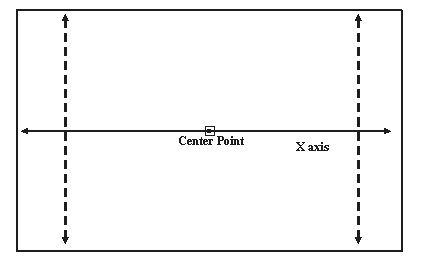 Diagram 1
Diagram 1
Establish a secondary line (Y axis) that is 90° to the primary line.
From the center point measure out an equal distance (points A and B). Mark those points and using a trammel point scribe lines that arc and intersect from both A and B points.
Snap a line through the two intersecting points and center point on the X axis. This establishes the secondary line Y. The two lines must be 90° to one another. See Diagram 2
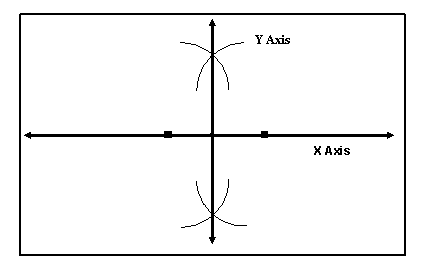 Diagram 2
Diagram 2
Determine that lines X & Y are 90° to one another using the 3, 4, 5 method. To do this measure from the center point out along the X axis 4 feet and then from the center point measure 3 feet along the Y axis. The two points on the X and Y axis should be 5 feet indicating that the lines are 90° (perpendicular) to each other. See Diagram 3
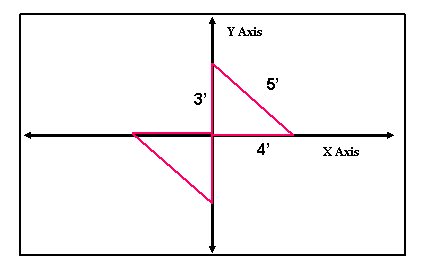 Diagram 3
Diagram 3
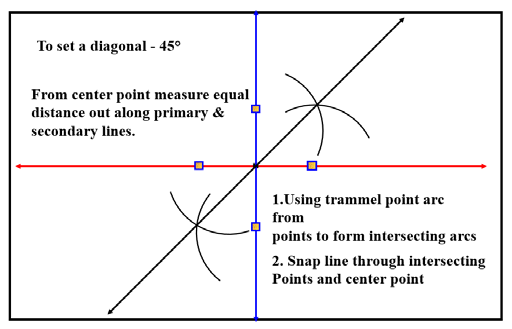
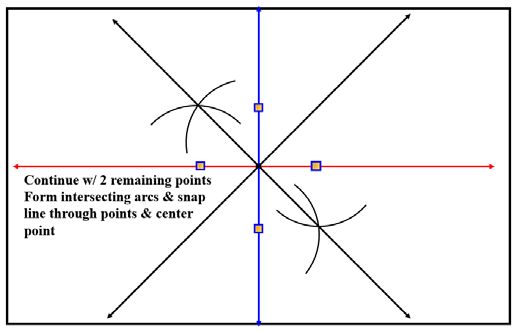
Fitting the Border:
Measure the distance from the last plank in the row to the wall. Mark the plank and cut it against the mark. Lay the plank in place, making sure that the cut edge is against the wall.
Fitting Around Irregular Objects: Make a pattern out of heavy paper to fit around pipes and other irregularities. Place the pattern on the plank, trace cutting along the trace lines.
* Mixed Materials resilient when inset into a carpet tile installation using LokDots may be installed without adhesive using a loose-lay method. In areas of high traffic/rolling loads, a full spread of 4151 adhesive is required with resilient. Although a limit has not been established on multiple pieces, we do not approve a whole field application of loose lay resilient locked in by a perimeter of carpet tile.
7. Maintenance
To prevent indentation we recommend that you put protective non-staining pads on the legs of heavy furniture (pianos, chairs, tables etc.). Also if you have furniture with rolling casters, the casters need to be a minimum of 2”diameter.
Adhering tape to the surface of your resilient flooring could damage the surface.
Do not use tape to secure floor protection directly to the floor during construction or renovation. Instead, adhere tape to the material used to protect the floor and secure it to the base molding along the wall. A material such as ram board can also be used to protect your flooring.